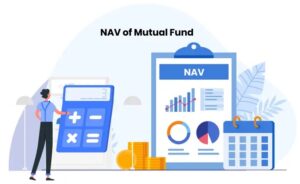
Mutual Fund NAV (Net Asset Value) is the most common word used in the Mutual Fund industry and it is closely watched. In the Stock Market, the price of a particular share goes up and down, and investors experience profits or losses accordingly. Likewise, in Mutual Funds, if the NAV goes up, investors make profits and vice versa.
What is NAV?
We all know that in Mutual Fund Investments, we do not get shares directly, we get units of the particular scheme as per the investment amount.
Net Asset Value (NAV) is the price per unit of a Mutual Fund scheme.
NAV = Total Fund Assets (-) Total Fund Liabilities
NAV per Unit = Total Fund Assets (-) Total Fund Liabilities / Number of Units Outstanding
In most cases, when the NFO (New Fund Offer) opens for investment, the unit cost of Mutual Funds begins at Rs. 10/- and increases as the asset under the funds grows.
Assets: Assets of a Mutual Fund comprises of the cumulative market value of a particular fund’s investments, receivables, cash, cash equivalents, and other accrued income.
Liabilities: The liabilities include outstanding payments, money owed to the lenders, and other fees and charges that are owed to associated entities.
Let’s take an example.
| Market Value of Securities held by an Equity Fund | Rs. 8,00,00,000 |
| Cash & Equivalent Holdings | Rs. 1,00,00,000 |
| Liabilities of the funds | Rs. 3,00,00,000 |
| Total no. of Units | 10,00,000 |
NAV per Unit = (8,00,00,000 + 1,00,00,000 – 3,00,00,000) / 10,00,000
NAV would be Rs. 60/- per unit of a Mutual Fund Scheme.
So, if investors invest Rs. 1 Lac in the Equity Fund whose NAV per unit is Rs. 60/-, investors would get total 1666 units (Rs. 1,00,000/ Rs. 60/-) of that particular Mutual Fund Scheme.
Difference between Stock Price and NAV?
Most investors consider NAV and the share price of a stock as same. No doubt, there are similarities, however, they are not exactly the same. The calculation is different from each other. To calculate the price of equity shares, the liquid assets of a company are included. And the valuation of both liquid and non-liquid assets is taken into account, to calculate the NAV.
The exercise of evaluating the total worth of the portfolio is being done by all the mutual fund investment companies on a daily basis after the stock market closes at 3:30 p.m. The market reopens next day with the closing prices of the previous day. The fund houses accordingly deduct all the expenses to get the net valuation of the assets for the day and declare NAV daily at the end of the day.
A stock price indicates an actual sale and transactions between a seller and buyer on some public securities market (NSE/BSE). It is purely based on demand and supply. Whereas NAV is the worth of one unit of a mutual fund, which holds many securities.
Stock prices fluctuate every second whereas the Mutual Fund houses declare NAV at the end of the day.
How should investors interpret NAV?
New investors pay a lot of attention to NAV. Comparing two funds based on NAV only is a completely wrong way to choose funds to invest in. Performance matters the most.
For example, you have Rs. 1,00,000/- to invest in Equity Fund. There are two schemes with similar portfolios.
Scheme no.1 has a NAV of Rs. 100, while Scheme no.2 has a NAV of Rs 50/-.
You will get 1000 units of the first scheme and 2000 units of the second. If both schemes grow by 20%, the NAV of scheme no.1 would move up to Rs. 120/-, while the other scheme would increase to Rs. 60.
Your investment would have grown as follows in both cases:
Scheme no.1: NAV of Rs. 120 × 1000 units = Rs. 1,20,000/-
Scheme no.2: NAV of Rs. 60 × 2000 units = Rs. 1,20,000/-
Though the NAV of scheme no.2 is half of that of scheme no.1, the value of the investment is the same. Returns did not increase even if the NAV of scheme no.2 is 50% lesser as compared to scheme no.1.
Hence, NAV is to be ignored if the portfolios of the two schemes are identical.
The NAV calculation does not correlate with the fund’s performance. Just because a fund has a lower net value does not make it a lucrative investment. Therefore, investors should not make it a deciding factor while choosing funds to invest in.
Rather, past performance of that fund, Risk-Reward Ratio, Fund Manager’s expertise, experience, and Expense Ratio is more important factors to look into.
Investment Services in Nashik, Investment Services in Thane, Investment Services in Jalgaon, Investment Services in Pune
